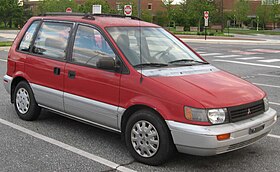Mitsubishi RVR
| Mitsubishi RVR | |
|---|---|
 |
|
| Overview | |
| Manufacturer | Mitsubishi |
| Also called | Mitsubishi ASX |
| Production | 1991–2002 2010–present |
| Body and chassis | |
| Class |
Compact MPV (1991–2002) Compact crossover SUV (2010–present) |
| First generation | |
|---|---|
 |
|
| Overview | |
| Also called | Mitsubishi Space Runner Mitsubishi Expo LRV Dodge Colt Wagon Eagle Summit Wagon Plymouth Colt Vista Wagon |
| Production | 1991–1999 |
| Assembly | Nagoya Plant, Okazaki, Aichi Japan |
| Body and chassis | |
| Class | Compact MPV |
| Body style | 4-door wagon |
| Layout | Front-engine, front-wheel-drive or four-wheel-drive |
| Related |
Mitsubishi Chariot Mitsubishi Galant |
| Powertrain | |
| Engine | Sports Gear trim package 4WD straight-4 DOHC 4G63 engine 2000cc straight-4 4D68 engine 2000cc Diesel Direct Hyper Sports Gear R trim package 4WD 4G63 engine 2000cc straight-4 DOHC X/X2 trim package 4WD straight-4 DOHC 4G63 engine 2000cc FWD straight-4 SOHC 4G93 engine 1800cc |
| Transmission | 5-speed manual 4-speed automatic 4-speed INVECS semi-auto |
| Dimensions | |
| Wheelbase | 2,520–2,550 mm (99.2–100.4 in) |
| Length | 4,290–4,480 mm (168.9–176.4 in) |
| Width | 1,695–1,740 mm (66.7–68.5 in) (JDM vehicles at 1695mm only) |
| Height | 1,625–1,730 mm (64.0–68.1 in) |
| Curb weight | 1,380–1,545 kg (3,042–3,406 lb) |
| Second generation | |
|---|---|
 |
|
| Overview | |
| Also called | Mitsubishi Space Runner |
| Production | 1997–2002 |
| Assembly | Nagoya Plant, Okazaki, Aichi Japan |
| Body and chassis | |
| Class | Compact MPV |
| Related | Mitsubishi Chariot Grandis |
| Powertrain | |
| Engine | 1.8 L, 2.0 L, Mitsubishi Sirius engine 2.4 L w/GDI |
| Dimensions | |
| Length | 4,280–4,480 mm (168.5–176.4 in) |
| Width | 1,695–1,780 mm (66.7–70.1 in) |
| Height | 1,650–1,720 mm (65.0–67.7 in) |
| Third generation | |
|---|---|

Mitsubishi RVR (second facelift)
|
|
| Overview | |
| Also called | Mitsubishi ASX Mitsubishi Outlander Sport |
| Production | 2010–present |
| Assembly | Japan: Okazaki, Aichi (Nagoya Plant) Brazil: Catalão China: Fuzhou, Fujian Indonesia: Pulo Gadung, Jakarta Malaysia: Kuala Lumpur (TCMA) USA: Normal, Illinois (MMNA) (until 2015) |
| Body and chassis | |
| Class | Compact crossover SUV |
| Body style | 5-door wagon |
| Layout | Front-engine, front-wheel-drive or four-wheel-drive |
| Platform | Mitsubishi GS platform |
| Related |
Citroën C4 Aircross Peugeot 4008 Mitsubishi Lancer Mitsubishi Outlander Dodge Caliber |
| Powertrain | |
| Engine | 1.8 L 4B10 2.0 L 4B11 2.4 L 4B12 1.8 L Mitsubishi 4J1 engine 1.6 L Mitsubishi 4A9 engine 1.8/2.2 L DI-D Mitsubishi 4N1 engine 1.6 L PSA DV6C diesel engine |
| Transmission | 5/6-speed manual 6-speed automatic 6-speed INVECS-III CVT |
| Dimensions | |
| Wheelbase | 2,670 mm (105.1 in) |
| Length | 4,295 mm (169.1 in) |
| Width | 1,770 mm (69.7 in) |
| Height | 1,625 mm (64.0 in) 64.2 in (1,631 mm) |
| Chronology | |
| Predecessor | Mitsubishi Pajero iO |
The Mitsubishi RVR is a range of cars produced by Japanese manufacturer Mitsubishi from 1991 to 2002 and from 2010 to present. The first two generations were classified as compact multi-purpose vehicles (MPV), whereas the model introduced in 2010 is a compact crossover SUV.
The RVR was Mitsubishi's Recreational Vehicle debut during the Japanese economic boom. The cars were sold at the Mitsubishi Japan dealership chain called Car Plaza. RVR is an acronym for "Recreation Vehicle Runner". In addition, the original logo had a Cyrillic Я on the first letter. It had a convenient size passenger cabin and spacious 4–5 person capacity with a youth-oriented approach, therefore making it more appealing to young people . Television commercials in Japan used Bugs Bunny and Daffy Duck as spokespeople. It was also developed and released during Japan's "bubble economy", and had gained popularity due to its ease of use sliding door on the passenger side.
It was a tall wagon, off-road model that sought awareness towards "sports gear" or outdoor lifestyles to other companies, similar to an approach used for the introduction of the Honda CR-V, allowing drivers to setting their own routes, and it had an especially good sales record in the beginning, even with the decline of the RV sales boom. Unfortunately due to declining sales, it was discontinued in August 2002.
The reintroduction of the "Sports Gear" RVR nameplate is an attempt to inherit the popularity of the first generation vehicle. It was released in Japan on February 17, 2010. It does not feature a rear sliding door, due to the current perception that SUVs have conventional doors, and sliding doors are typically installed on family vehicles. The RVR logo no longer uses the inverted Cyrillic "Я" on the first letter.
The trim level that is typically used is the grade name "Sports Gear", a feature Mitsubishi is reintroducing, such as Airtrek and Grandis.
The first RVR, introduced February 1991, is a compact MPV, manufactured between 1991 and 2002. It was known as the Mitsubishi Space Runner in Europe and Mitsubishi Expo LRV in the United States, while export markets in Asia and Oceania used the Japanese market name. The RVR was also sold by Chrysler as the Dodge/Plymouth Colt Wagon and Eagle Summit Wagon captive imports in North America. Its "tall wagon" appearance reflected a popular appearance which found favor with many international manufacturers, which can trace their beginnings to the 1978 concept car Lancia Megagamma.
...
Wikipedia
